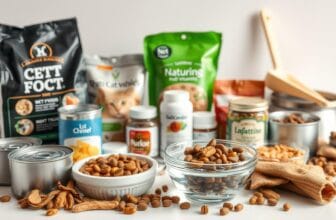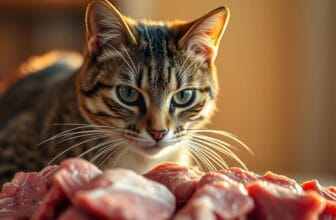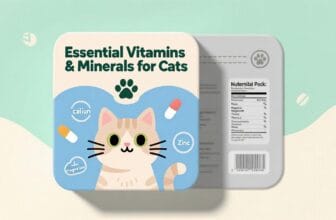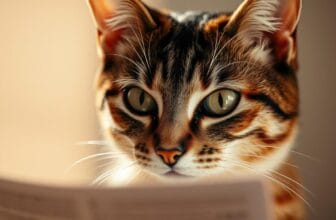
Table of Contents
Ever think about if you’re feeding your cat right? Creating the perfect cat feeding schedule is more than just filling a bowl. It’s about knowing your cat’s special nutritional needs.
Cats are complex creatures with changing dietary needs. The right feeding frequency can greatly affect their health and happiness. From kittens to older cats, each life stage needs a specific nutrition plan.
Knowing the right feeding frequency is key for pet owners. This guide will help you create a cat feeding schedule that keeps your pet healthy and happy.
Whether you’re new to cat parenting or want to improve your feeding routine, you’ll find valuable tips here. These insights will change how you think about your cat’s nutrition.
Understanding Your Cat’s Natural Feeding Patterns
Cats have unique eating habits driven by their biology. Their feeding patterns come from their natural instincts and stomach anatomy. These are different from what humans need to eat.
The Role of Stomach Anatomy in Feeding
A cat’s digestive system is made for hunting and quick nutrient absorption. Their stomach is compact and specialized. It’s designed to process small, protein-rich meals fast.
Unlike humans, a cat’s stomach empties quickly. It usually does so in 2-4 hours after eating.
- Small, concentrated stomach capacity
- Rapid nutrient absorption
- Protein-focused digestive system
Natural Hunger Cycles in Cats
Feline hunger cycles are linked to their hunting nature. Your cat’s body signals hunger about 8-10 hours after eating. This is similar to how wild cats hunt.
“Cats are natural hunters, designed to consume multiple small meals throughout the day.” – Veterinary Nutrition Experts
Impact of Wild Cat Feeding Habits
Wild cat feeding habits shape domestic cat behavior. In the wild, cats hunt and eat multiple small prey. This is why they prefer eating small, frequent meals.
| Feeding Characteristic | Wild Cats | Domestic Cats |
|---|---|---|
| Meal Frequency | 4-6 small hunts daily | 3-4 meals recommended |
| Protein Intake | 90-95% meat-based | High-protein diet preferred |
| Hunting Strategy | Opportunistic hunting | Scheduled feeding times |
Knowing these natural feeding patterns helps you create a better nutrition plan for your cat.
The Importance of Establishing a Cat Feeding Schedule
Creating a consistent cat feeding routine is more than just a simple daily task. It’s a critical aspect of your cat’s overall health and well-being. A structured feeding schedule provides numerous benefits that extend far beyond just filling your cat’s food bowl.
Cats thrive on predictability. Establishing a consistent cat feeding routine helps reduce stress and anxiety in your feline companion. When your cat knows exactly when to expect meals, it creates a sense of security and stability in their daily life.
- Reduces anxiety and behavioral issues
- Helps monitor eating habits
- Makes tracking health easier
- Supports digestive regularity
The feeding routine benefits extend to your ability to detect potential health problems early. By maintaining a regular feeding schedule, you’ll quickly notice any changes in your cat’s appetite or eating patterns. This can be crucial for identifying medical issues before they become serious.
Your cat’s feeding schedule becomes especially important during household transitions. Whether you’re moving, introducing a new pet, or dealing with changes in your family dynamic, a consistent feeding routine provides a comforting constant for your feline friend.
“A predictable feeding schedule is like a security blanket for cats, offering them comfort and stability in an ever-changing world.”
Professional veterinarians recommend establishing a routine that works for both you and your cat. This typically means feeding at the same times each day, using the same type of food, and creating a calm, consistent environment during meal times.
Age-Based Feeding Requirements
It’s key to know how to feed your cat based on their age. Each life stage has its own feeding needs. From kittens growing fast to adult cats needing steady food.
Good food helps your cat grow, stay energetic, and feel well. Feeding kittens and adult cats is different. It depends on their age and what they need.
Kitten Feeding Guidelines (0-6 months)
Kittens grow really fast in the first six months. They need special food. A good kitten feeding plan includes:
- Feeding 3-4 times daily
- Eating high-protein, calorie-rich kitten food
- Drinking plenty of fresh water
Kittens need about 2-3 times more calories than adult cats to grow fast.
Young Cat Feeding (6-12 months)
When your kitten gets older, you’ll change their food routine. You’ll start feeding them 2-3 times a day. Keep their food rich in nutrients.
- Start to switch to adult cat food
- Watch how much food they eat
- Make sure they stay at a healthy weight
Adult Cat Feeding Needs
Adult cats need a steady diet. Your adult cat’s food plan should focus on the right amount and balanced meals.
- Feed 1-2 times daily
- Choose food made for their age
- Adjust food amounts based on how active they are
Talk to your vet to make a feeding plan that fits your cat’s needs.
Calculating Daily Caloric Needs for Your Cat
Knowing what your cat needs to stay healthy is key. A cat calorie calculator is a tool to figure out how many calories your cat needs each day. Cats usually need 25 to 35 calories per pound of body weight daily. But, this can change based on many factors.
To find out your cat’s caloric needs, look at these important points:
- Current body weight
- Age and life stage
- Activity level
- Overall health status
- Spay/neuter condition
Pro tip: Body condition scoring is an excellent method to assess whether your cat is at a healthy weight. This method lets you see if your cat needs more or fewer calories.
“Nutrition is the foundation of your cat’s health and longevity.” – Veterinary Nutrition Experts
Different life stages need different amounts of calories. Kittens, active adults, and senior cats have different needs. A professional cat calorie calculator can give you specific advice for your pet.
Always talk to your vet to make a feeding plan that fits your cat’s needs. They can adjust the calories based on your cat’s metabolism, health, and lifestyle.
Creating an Optimal Cat Feeding Schedule
Creating the best feeding schedule for cats needs careful planning. It’s important to understand your cat’s nutritional needs. A good feeding schedule can help keep your pets healthy, prevent obesity, and keep their energy levels up all day.
Cats like routine. Their digestive systems work best with meals at the same times every day. Veterinarians suggest a routine that follows their natural hunting habits.
Morning Feeding Strategies
Morning meals are great for cats. Here are some tips:
- Feed breakfast within 30 minutes of waking up
- Give a balanced meal that keeps them energized
- Use measured portions to control calories
Evening Feeding Options
Evening meals are important for your cat’s diet. Consider these points:
- Feed dinner 2-3 hours before bedtime
- Avoid late-night meals to keep sleep uninterrupted
- Match portion sizes to your cat’s activity level
“Consistency is key in creating a successful feeding schedule for your feline friends.” – Veterinary Nutrition Expert
For homes with multiple cats, feeding them at the same time helps avoid fights. Having separate feeding areas can also reduce stress and make mealtime peaceful.
Wet Food vs Dry Food Feeding Frequencies

Choosing the right feeding schedule for your cat is key. It depends on whether you feed them wet or dry food. Each type meets different nutritional needs.
Wet cat food has 70-80% moisture. This means your cat might need to eat more often. Dry food, being less moist, can be left out for longer.
- Wet Food Advantages:
- Higher moisture content
- Closer to natural prey diet
- Helps with hydration
- Dry Food Advantages:
- More convenient storage
- Longer shelf life
- Can help maintain dental health
Vets often suggest a mix of both. Feed wet food 2-3 times a day and offer dry food for grazing. This balances nutrition and meets their natural eating habits.
Pro tip: Always consult with your veterinarian to determine the optimal feeding schedule for your specific cat’s age, weight, and health conditions.
When choosing between wet and dry food, consider your cat’s likes and needs. Some cats prefer small, frequent meals. Others do better with fewer, larger portions.
Signs Your Cat’s Feeding Schedule Needs Adjustment
It’s important to watch how your cat eats to keep them healthy. Small changes in how they act and look can mean you need to change their meal times. Knowing when your cat is eating too much or too little helps them get the right food.
By paying attention to your cat’s daily habits, you can spot nutritional problems early. Cats show their health in many ways. This helps you make better choices about their food.
Behavioral Red Flags
Look out for these signs that might mean your cat’s eating schedule is off:
- Constant begging or food aggression
- Sudden loss of appetite
- Increased vocalization around mealtimes
- Unusual food-seeking behaviors
Physical Changes to Monitor
Your cat’s body can tell you a lot about their eating:
- Weight fluctuations – unexpected weight gain or loss
- Dull or patchy coat condition
- Decreased energy levels
- Changes in muscle tone
If you see these changes often, talk to your vet. They can figure out if you need to change their food schedule or if there’s a health problem.
Regular monitoring and proactive care are key to maintaining your cat’s nutritional health.
Special Considerations for Multiple Cat Households
Managing meal times for multiple cats can be tough. Each cat has its own diet, personality, and eating style. You need to pay close attention and plan carefully.
Feeding many cats requires a smart plan. Some cats might eat more because they’re bossy. Others might be shy or scared to eat.
- Create separate feeding stations to reduce competition
- Use microchip-activated feeders for individualized meal control
- Monitor each cat’s food intake closely
- Prevent food guarding behaviors
Here are some tips for managing meal times well:
- Designated feeding areas: Set up multiple feeding zones to minimize conflict
- Scheduled individual feeding times: Rotate feeding schedules to accommodate different cat personalities
- Technology solutions: Invest in smart feeders that recognize individual cats
Special diets can make things harder. If one cat needs a special diet, use separate rooms or elevated stations. This way, they get the right food without other cats bothering them.
Patience and observation are key to successfully feeding multiple cats in one household.
Health Conditions That Affect Feeding Frequency

When your cat has health issues, their diet is very important. This includes cats with diabetes or kidney disease. Each condition changes how and when you should feed your cat.
Some health problems need special diets. Your vet might suggest:
- Diabetes
- Kidney disease
- Hyperthyroidism
- Digestive disorders
Cats with diabetes need to keep their blood sugar in check. Their feeding schedule might include:
- Consistent meal times
- Carefully measured portions
- Coordinating meals with insulin injections
Cats with kidney disease also need special care. They might need:
- Low-phosphorus diets
- Smaller, more frequent meals
- Increased moisture in their food
“Proper nutrition can significantly improve your cat’s quality of life with chronic health conditions.” – Veterinary Nutrition Expert
Always talk to your vet to create a diet plan for your cat. Regular check-ups and diet changes are important for managing health issues.
The Pros and Cons of Free Feeding
Choosing the right way to feed your cat can be tough. Free feeding means leaving food out all the time. It might seem easy, but it has big health and nutrition concerns.
It’s important to weigh the pros and cons of free feeding versus portion control. You need to think about your cat’s special needs and how they live.
Benefits of Measured Portions
Measuring out food for your cat has many benefits:
- Precise calorie management
- Better weight control
- Easy tracking of food intake
- Quick detection of appetite changes
Risks of Constant Food Access
Free feeding can cause health problems for your cat:
| Risk Factor | Potential Consequences |
|---|---|
| Obesity | Weight-related health issues |
| Overeating | Metabolic disorders |
| Reduced Activity | Decreased muscle tone |
While some cats can handle free feeding, most do better with set meal times and measured portions. Think about your cat’s age, how active they are, and their health when picking a feeding method.
Vets usually suggest switching to measured portions to avoid weight problems and keep your cat healthy.
Impact of Spaying/Neutering on Feeding Requirements
Spaying or neutering changes your cat’s nutritional needs. These changes can affect their metabolism, leading to weight gain if not managed. Adjusting their diet is key.
After surgery, cats’ metabolism slows down. Hormone levels drop, so they need fewer calories. It’s important to manage their diet to avoid obesity.
- Metabolism slows by approximately 20-30% after surgery
- Calorie intake should be reduced by 25-30%
- Protein-rich, low-calorie diets work best for neutered cats
Vets suggest watching your cat’s weight closely after surgery. Adjusting portion sizes and feeding frequency can help keep them healthy.
Using portion control and special diets can prevent weight gain. Talk to your vet about a diet plan that fits your cat’s needs after surgery.
“Proper nutrition after spaying or neutering is crucial for long-term health and weight management.” – Veterinary Nutrition Experts
Using Food Toys and Interactive Feeders

Cat puzzle feeders are changing how we feed our cats. They do more than just give food. They also keep cats’ minds sharp and slow down eating, just like they do in the wild.
Interactive feeders are great for your cat’s health and happiness:
- They slow down eating and stop overeating
- They keep your cat’s mind busy
- They make your cat feel like they’re hunting
- They help indoor cats stay active and not bored
When picking out cat puzzle feeders, think about your cat’s age, how smart they are, and their personality. Some cats get really good at these toys fast. Others might need something easier.
| Feeder Type | Difficulty Level | Best For |
|---|---|---|
| Rolling Kibble Dispensers | Easy | Beginners, Playful Cats |
| Stationary Puzzle Boards | Medium | Active Cats, Problem Solvers |
| Multi-Chamber Food Mazes | Advanced | Intelligent Cats, Enrichment |
To start slow feeding, begin with simple puzzle feeders. Then, make them harder as your cat gets better. Watch how your cat does and change things up to keep mealtime fun.
Common Feeding Schedule Mistakes to Avoid
Keeping your cat healthy means watching their food closely. Many owners make mistakes that hurt their cat’s health. These mistakes can affect their nutrition and overall health.
Understanding Overfeeding Risks
It’s important to avoid overfeeding your cat. A study from the University of California, Davis found 41% of cats are overweight. This is often because of bad feeding habits.
Too many calories can cause big health problems. These include:
- Diabetes
- Joint problems
- Reduced mobility
- Decreased life expectancy
Navigating Inconsistent Feeding Times
Feeding your cat at the same times every day is key. It keeps their metabolism healthy and stops bad behavior. If you don’t feed them regularly, it can cause:
- Digestive disruptions
- Increased anxiety
- Unpredictable hunger patterns
To avoid these issues, set up a structured feeding routine. Match it to your cat’s natural eating times. Use the right amount of food and stick to the same times every day. Your cat will thank you for the routine.
“A consistent feeding routine is key to your cat’s physical and emotional well-being.” – Veterinary Nutrition Experts
Always talk to your vet to make a feeding plan that fits your cat’s needs. This will help avoid common mistakes.
Transitioning Between Different Feeding Schedules
Changing cat feeding times can be tough for both you and your cat. Cats like routine, and sudden changes can stress them out and upset their stomachs.
Here are some important tips for changing your cat’s diet or feeding schedule:
- Make changes gradually
- Watch how your cat reacts
- Be patient during the change
Planning is key for a smooth transition. Start with small changes over 7-10 days. This lets your cat adjust without too much upset.
| Transition Phase | Duration | Key Actions |
|---|---|---|
| Initial Adjustment | Days 1-3 | Introduce new feeding times slowly |
| Gradual Modification | Days 4-7 | Shift meal times by 15-minute increments |
| Full Transition | Days 8-10 | Stabilize new feeding schedule |
Look out for signs of stress or stomach problems during the change. If your cat seems really upset or sick, talk to your vet for help.
Remember, every cat is unique. What works for one might not work for another.
Stay consistent and patient. With time and gentle help, your cat will get used to the new feeding schedule.
Conclusion
Creating the best cat feeding routine is all about knowing your cat’s needs. It’s not just about giving them food. It’s about making sure it’s right for their age, health, and how active they are. This can really make your cat happier and bring you closer together.
Every cat is different, and they need a special feeding plan. This plan should take into account their metabolism, how active they are, and any health issues they might have. Your vet is the best person to help you make a plan that’s just right for your cat.
By following the tips in this guide, you can make feeding time special. It’s important to be consistent, control the amount of food, and watch how your cat eats. Learning about your cat’s diet needs will make them healthier and happier.
Your effort to feed your cat well will really pay off in the long run. Keep an eye on how they’re doing, be ready to make changes, and always think about what’s best for them.
FAQ
How many times a day should I feed my cat?
The number of meals depends on your cat’s age. Kittens need 3-4 small meals a day. Adult cats do best with 2 meals. Senior cats might need smaller, more frequent meals. Always talk to your vet to find the best schedule for your cat.
Can I leave dry food out all day for my cat?
Free feeding is easy but can cause obesity. It’s better to feed measured portions to keep your cat healthy. If you free feed, measure the food carefully to avoid overeating.
How do I know if I’m feeding my cat the right amount?
Check your cat’s weight with body condition scoring. You should feel their ribs without fat, and see a waist from above. Your vet can help figure out the right calories for your cat’s age, weight, and activity level.
What’s the difference between wet and dry cat food feeding schedules?
Wet food needs more frequent meals because it spoils quickly. Dry food lasts longer and is good for free feeding. Vets often suggest a mix of both for moisture, protein, and dental health.
How do I change my cat’s feeding schedule?
Change gradually over 7-10 days. Start by mixing a little of the new schedule with the old one. Slowly increase the new amount. Watch for upset stomach or stress, and ask your vet if you have problems.
Do spayed or neutered cats need a different feeding schedule?
Yes, they have slower metabolisms and gain weight easily. You’ll need to cut their calories by 20-30% and watch their weight closely. Adjust portions and consider lower-calorie food, as advised by your vet.
How can I feed multiple cats with different dietary needs?
Use separate feeding areas or microchip-activated feeders for each cat. Watch meal times closely. If needed, feed cats in different rooms. Your vet can help create a plan for feeding multiple cats.
Are food toys and interactive feeders beneficial?
Yes, they provide mental stimulation and slow eating. They mimic hunting, which is good for indoor cats. Choose toys based on your cat’s age and mobility, and introduce them slowly to avoid frustration.
What are the signs that my cat’s current feeding schedule isn’t working?
Look for sudden weight changes, loss of appetite, or food aggression. Also, watch for changes in coat condition or energy levels. Regular weigh-ins and body checks can spot problems early.
How do health conditions affect a cat’s feeding schedule?
Conditions like diabetes or kidney disease can change feeding needs. Always follow your vet’s advice, which may include different meal times, sizes, or diets to manage the condition.







